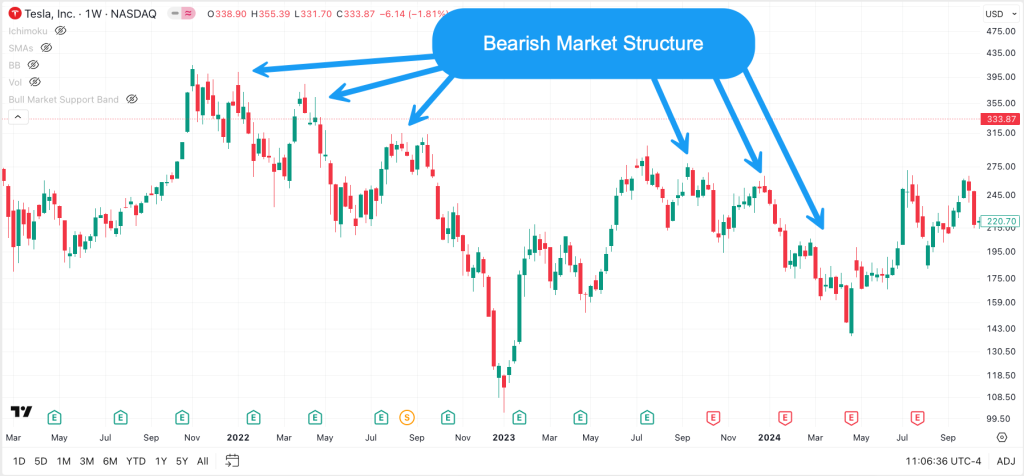For years, I was an “all-in” Tesla (TSLA) investor.
At one point my entire portfolio was this single stock, captivated by its innovation, market dominance, and the thrill of watching its value soar. I started investing in 2020, riding the wave of Tesla’s huge rise, and I still hold excellent gains.
But I realized this approach came with risks I couldn’t ignore. Today, I’m sharing why I’ve shifted away from being an all-in TSLA investor, guided by lessons I wish I’d learned earlier. This change has transformed how I think about investing, and it might just do the same for you.

Download the Blueprint on Skool
If you don’t have a copy yet, consider downloading my free 6 Month Blueprint. Find Blueprints and free courses in our Skool Community
The All-in Trap: My TSLA Journey
Like many, I was drawn to TSLA’s rise—it felt like the ultimate “one-stock wonder” that defied market norms. I was convinced its growth trajectory would outpace any diversified approach.
Let me be clear: no one’s responsible for my financial decisions but me.
Still, it didn’t help that passionate TSLA influencers, with their compelling arguments about Tesla’s unbeatable fundamentals—game-changing technology, visionary leadership from Elon Musk, and future catalysts around the corner—had me hooked. I bought into the hype, thinking, “Why invest in anything else?” I own two Teslas and believed the future of Robotaxis was unmatched. For a while, it worked—my portfolio soared.
But then came the volatility…
Sharp dips, market corrections, and unexpected news sent my portfolio on a rollercoaster ride. From 2022 to 2025, TSLA’s performance often lagged while others, like NVIDIA, surged ahead. Over three years, other stocks outpaced it by wide margins, and my all-in bet meant I missed those gains.
Here’s the hard truth: fundamentals don’t drive short-term stock prices.
When the chart’s bearish, even the best story won’t save you from a decline. A basic look at market structure in 2022 would’ve signaled it was time to pivot, but I was too mesmerized by Tesla’s narrative, and I knew nothing about price charts.

Don’t get me wrong—TSLA still makes up a big part of my portfolio, and I’m bullish on its future. I love the company, but I’ve learned that going all-in on one stock, no matter how great, is a gamble dressed up as conviction. If you’re heavily invested in TSLA, my journey might make you think twice about putting all your eggs in one basket.
The Turning Point: Technical Analysis Opened My Eyes
The real turning point in my investing journey wasn’t a single event but a shift in perspective: technical analysis.
When I started my trading journey I quickly discovered a price chart and realized they tell the story first, while fundamentals catch up later.
I’d been obsessed with TSLA’s earnings reports and innovation pipeline, thinking its strong fundamentals guaranteed success. But the charts revealed a different truth: TSLA’s price action signaled trouble long before any bad news was released.
This was a revelation.
I saw that clinging to a stock based on its story alone left me vulnerable to timing missteps. The charts clearly showed us when the momentum shifted, and that’s when I knew I needed a new approach.
The Fundamentals Trap: Why Price Charts Matter More
One of the hardest lessons I learned was letting go of TSLA’s fundamentals.
On paper, they looked irresistible. It’s easy to think, “With fundamentals this good, and a growing list of catalysts coming, TSLA has to keep rising!”
But here’s the catch: fundamentals alone don’t dictate short-term performance... The price chart does.
I got trapped thinking no other stock could perform as well as TSLA, mesmerized by its story. Yet, over the last three years, many stocks have outperformed it by wide margins.
Following the price chart—watching support levels, resistance, and momentum—revealed when I should have taken some off the table, even with stellar fundamentals.
For instance, a stock might look “cheap” based on discounted future cashflows, but if its price keeps hitting resistance, or the market structure is currently bearish, it won’t help.
Meanwhile, other opportunities with less impressive fundamentals were soaring because their charts showed bullish patterns. This shift in focus—from fundamentals to price action—helped me break free from the all-in mindset and seek diversification where the numbers (and charts) aligned.
Why Diversification Beats Going All-In
The main reason people like diversification is that no single stock stays the “best” forever. As a stock’s price changes over time (going up or down), the balance between how much you could lose (risk) and how much you could gain (reward) shifts too. For example:
- If you buy a stock at $100 and it rises to $150, the chance for even more gains might shrink, while the risk of it dropping stays high. At that point, it might not be as smart to keep everything there.
- By diversifying, you can move some money to other stocks where the reward looks bigger compared to the risk right now.
It’s like shopping:
You don’t buy only one fruit because it might spoil fast. You get a mix so you always have something fresh.
Why You Should Switch from “All-in-One Stock” to Diversification
If you put most of your money into just one stock, it can feel thrilling when that stock goes up—you make big gains! But here’s why you regret it and should consider switching to diversification:
- It Lowers Big Risks: One stock can crash suddenly because of bad news (like a company problem or market slump). If that’s your only investment, you could lose a lot. With diversification, you’re not depending on just one thing, so losses hurt less.
- It Helps You Adapt to Market Changes: Stocks don’t stay hot forever. What was a great pick last year might slow down as its price gets too high, making future gains harder. Diversifying lets you check regularly and shift money to fresher opportunities where the “reward” (potential profit) is higher than the “risk” (potential loss).
- It Can Lead to Steadier Growth Over Time: Some people think one “super stock” will make them rich fast (which can happen), but studies show mixing investments often gives more reliable results. You avoid wild ups and downs, and you might catch wins from different areas (like tech, health, or energy stocks).
- It’s Less Stressful for Your Mind: Watching one stock swing daily can make you anxious. Spreading out gives peace of mind—you sleep better knowing your money isn’t all tied to one company’s fate.
I used to dismiss diversification as something for investors who hadn’t done their homework—like those who settle for mutual funds without digging deeper.
After all, TSLA influencers had “proven” through their research that Tesla was unbeatable: unmatched innovation, a visionary leader in Elon Musk, and fundamentals that screamed long-term dominance.
That was my mindset too—why spread my bets into lesser companies when nothing compared to TSLA?
But here’s the reality check:
Stock prices don’t always follow the “best company” narrative in the short term. Market dynamics, sentiment shifts, and momentum can make even stellar stocks underperform while others surge.
My wrong idea about diversification painted it as passive and uninformed, but I’ve learned it’s actually a strategic tool. Now, I’m focused on building a portfolio of say 10 great stocks with strong momentum, identified through technical analysis. This active approach lets me capture opportunities beyond TSLA without abandoning what makes it special.
How I’m Rebalancing: A Practical Shift
As of now, I’ve only sold TSLA in non-taxable accounts like my TFSA and RRSP to maximize tax efficiency, and I’m happy not being 100% TSLA. I might reduce my position further if the risk-reward looks favorable, but I’m also content with my current allocation.
Using technical analysis, if I rebalance more, I aim to sell TSLA at resistance zones and buy other stocks at support zones. While TSLA’s chart looks bullish, other stocks show strong potential too.
Bottom line, rebalancing reduces risk and stress, which matter more to me now, so I’m happier with my portfolio. This wasn’t about abandoning TSLA, but about finding balance—keeping a good stake while exploring opportunities in stocks with great potential upside based on their charts. TSLA is still my biggest position.
Lessons Learned and Why This Matters
Looking back, being an all-in TSLA investor taught me the value of conviction—but also its limits. The best approach isn’t about picking one winner and riding it forever; it’s about adapting to changing risk-reward dynamics, guided first by the story the charts tell.
Today, my portfolio is starting to reflect a strategy where I regularly assess the charts, rebalance when needed, and prioritize diversification over devotion to a single stock.
If you’re an all-in investor—whether it’s TSLA or another stock—consider this: the market doesn’t reward blind loyalty. It rewards flexibility and informed decisions. Start by studying the price charts of your holdings and think about their risk-reward ratios.
If they’re trending unfavorably, explore spreading your investments. You might find, as I did, that letting go of the all-in mindset opens the door to a more resilient financial future.


